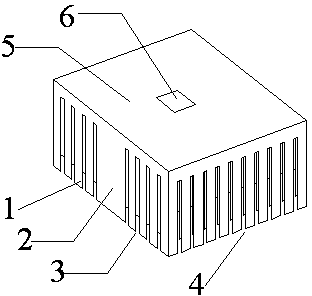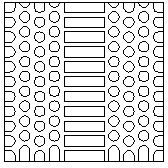Radiator for concentrating photovoltaic photoelectric-converting receiver
A photoelectric conversion and concentrating photovoltaic technology, applied in the field of solar power generation, can solve the problems of increased product cost, increased cost of connecting wires and external power supply, increased production workload, etc., and achieves the effect of simple structure and low production cost
- Summary
- Abstract
- Description
- Claims
- Application Information
AI Technical Summary
Problems solved by technology
Method used
Image
Examples
Embodiment Construction
[0014] The present invention will be further described below in conjunction with the accompanying drawings.
[0015] A radiator for concentrating photovoltaic photoelectric conversion receivers, such as Figure 1~2 As shown, it includes secondary cooling fins 1 , main cooling fins 2 , radiator bottom plate 5 , and installation area 6 for concentrating photovoltaic photoelectric conversion receivers. The secondary cooling fin 1 is composed of a multi-row cylindrical array or a multi-row elliptical cylindrical array and a graphic array formed by splicing the surrounding array into a square and a semicircle. The internal and surrounding arrays of the secondary cooling fin 1 are interlaced in pairs Yes, the main heat dissipation fins 2 are arranged in a row of rectangular column arrays, and there is a mounting area 6 for concentrating photovoltaic photoelectric conversion receivers on the bottom plate of the radiator 5 .
[0016] The using method of the present invention is:
[...
PUM
 Login to View More
Login to View More Abstract
Description
Claims
Application Information
 Login to View More
Login to View More - R&D
- Intellectual Property
- Life Sciences
- Materials
- Tech Scout
- Unparalleled Data Quality
- Higher Quality Content
- 60% Fewer Hallucinations
Browse by: Latest US Patents, China's latest patents, Technical Efficacy Thesaurus, Application Domain, Technology Topic, Popular Technical Reports.
© 2025 PatSnap. All rights reserved.Legal|Privacy policy|Modern Slavery Act Transparency Statement|Sitemap|About US| Contact US: help@patsnap.com


